Exploring The World Of BattleTech Part Two: Backstory & Setting
August 29, 2016 by crew
We’re back, Beasts of War, for further explorations into one of the most richly detailed, vastly expansive, and tenaciously enduring universes in the history of Sci-Fi wargaming. I’m talking, of course, of BattleTech. I am your host, BoW contributor @oriskany, hoping to show you just a sliver of what this staggering franchise has to offer.
If you’re just joining us, please take a moment to check out Part One of our series, an Introduction to BattleTech.
Created by FASA in 1984 and one of the true powerhouses of Sci-Fi wargaming in the 80's and 90's, BattleTech is the franchise that just won’t die. Conversely, under new ownership it has tapped into the loyalty of its original fan base and the imagination of a new generation of gamers, and now stands poised to make the mother of all comebacks.
Like all great gaming franchises, part of what makes BattleTech such a giant is its backstory. The labyrinthine depth of its history, the intricate tapestry of its campaign area, and the myriad of choices it offers its players - all can be equalled by very, VERY few other settings in Sci-Fi wargaming. Let’s take the briefest of possible surveys together.
The Inner Sphere
The BattleTech universe is primarily set in the so-called “Inner Sphere,” an expanse of space with Earth at its centre. The Inner Sphere measures about 500 light years across, contains some two million stars, with about two thousand inhabited star systems.
Depending on when a campaign is set in the BattleTech timeline, the Inner Sphere is divided into vast nations usually called “Successor States.” These states are almost always at war, recovering from the last war, or on the brink of the next war. Between these kingdoms, smaller states occasionally split off in rebellions, uprisings, or civil wars.
Surrounding the Inner Sphere is a fringe curtain of space called the Periphery, where colonization is much more sparse. Small, independent governments subsist out here, often lashing out against each other in small “bush wars,” fending off expansion by one of the Successor States, or quelling renegade mercenaries or pirates.
The Houses
Each Successor State is controlled by a feudal house, ruled by a noble dynastic family. Earth itself (usually called Terra) is typically a neutral territory, ruled by corporations, multilateral coalitions, quasi-religious orders, or their own independent government.
The five houses are loosely based on cultures we may find familiar. The Lyran Alliance, for example, is ruled by House Steiner, a vaguely Germanic-Scandinavian society. The Free Worlds League is a generally “American” nation governed by House Marik, while the Capellan Confederation is ruled by House Liao, loosely based on China.
Rounding out the Successor States are the Draconis Combine, ruled by a Japanese-inspired House Kurita, and finally the Federated Suns ruled by House Davion, a loosely-inspired throwback to the society and traditions of the United Kingdom.
This isn’t to say that BattleTech is cleanly split into these five simple factions. Between and within these alliances, innumerable nations rise and fall, and dozens of smaller governments rule along the Periphery. Each of these is fully developed in resource books and novels, creating a true “universe” in which players can lose themselves.
The Wars Of Succession
I’m actually not kidding when I say that trying to summarize a millennia of BattleTech history in one article is almost as hard as trying to summarize real history, say … since the Norman Invasions. The BattleTech backstory has been fleshed out to THAT level of near-Silmarillion detail. Nevertheless, let’s have a go at the highlights.
Following the development of FTL travel and an explosion of interstellar expansion, colonial states began to break away from the Terran government. These interstellar states (the earliest manifestations of the houses mentioned above) then fought with each other for centuries until they finally fused together into the “Star League” in 2571.
The Star League heralded 200 years of peace and technological growth until the ruling First Lord was befriended, betrayed, and put to death (along with his whole family) the usurper Stefan Amaris. This sparked a savage war to save the Star League, eventually won by the incomparable military figure of BattleTech: General Aleksandr Kerensky.
But in the aftermath, even Kerensky couldn’t keep the peace. The “Successor States” again went to war over the Star League’s future until finally, Kerensky could take no more. Appalled by what the Star League had become, he simply left known space to form his own vision of the future. About 80% of the Star League’s armies went with him.
Bereft of their idealistic leader, the Successor States rebuilt their armies and launched into a series of apocalyptic “Wars of Succession” which shattered whatever remained of the Star League and its epoch of utopian progress. Genocide was undertaken on a planetary scale, and humanity backslid centuries both socially and technologically.
The Clans
The Wars of Succession (four in all, plus several other shattering conflicts) continued for hundreds of years until finally, in 3050, a new threat exploded out of the Periphery. This new enemy launched an unstoppable interstellar blitzkrieg, overrunning dozens of planets with vastly better soldiers, technology, and tactics. The Clans had arrived.
Only gradually did the reeling Successor States realize who the Clans were: The descendants of Kerensky and the armies he’d taken with him centuries ago. With a ruthlessly militaristic caste system based on genetic engineering, Clan society is perhaps a little twisted by their generations of struggle for survival in deep space.
Once there were over twenty Clans, but many are now extinct since these guys love fighting even with each other. They are generally divided into two camps, the “Warden” Clans who believe they’ve inherited a mission to protect Humanity, and Crusader Clans who want to invade all the way to Terra and re-establish the lost rule of Kerensky.
Recent Events
To stop the Clans, armies of the Inner Sphere soon united under the direction of ComStar, the organization on Terra that had always maintained “hyperpulse generators” that allowed all FTL communications. But after centuries of wielding such immense power, ComStar had evolved into a quasi-religious order as well as a technological entity.
Although they never ejected the Clans from the Inner Sphere, ComStar helped stop their invasion and it almost looked as if the Star League might finally be re-established. But when the Houses withdrew their support from the “religious” zealots of ComStar (the Word of Blake), another round of gigantic wars engulfed the Inner Sphere.
Known as the “Jiyhad,” this war involved every major faction and lasted over a decade. It also saw the first use of weapons of mass destruction in centuries. Finally, the Word of Blake was defeated on Terra in 3081. Terra became the capital world of its own small republic and a shaky peace finally settled over much of the Inner Sphere.
Then came the “Dark Age,” the most recent era of BattleTech history. In the early 3130s, a series of attacks have brought down the hyperpulse generator network, leaving each planet effectively isolated. Recrimination, fear, and blame have taken hold, and war threatens to erupt anew as no one can identify the source of these attacks.
Mercenaries & Solaris VII
Yet even these dozens of republics, clans, houses, kingdoms, and federations are only the core choices available to BattleTech players. In addition to the myriad of smaller powers along the borders of the Successor States or out on the Periphery, one a popular option for mechwarriors remains: The mercenaries.
BattleTech depicts such a war-torn society that long-standing mercenary companies, some with battle records centuries long, exist as fully-equipped military assets available for hire. Such outfits regularly take contracts with various governments, enabling players to play their armies wherever they want in the BattleTech universe.
Meanwhile, there’s also Solaris VII, a planet set aside for gladiatorial ‘mech combat. Much the way jousting tournaments kept knights out of trouble between the endless feudal wars in the Middle Ages, so Solaris VII offers yet another avenue of BattleTech play … at least until the next war inevitably ignites.
As any “mechwarrior” familiar with this franchise will quickly tell you (or hopefully point out in the comments below), this article barely scratches the most superficial surface of BattleTech’s history and setting. If you want the full story, you’ve got 160+ novels to read, plus 200+ supplements for the wargames and RPGs.
Do you have questions, comments, or your own BattleTech stories? Do you have a favourite House or Clan? Drop your comments below, and come back next week when we dig into the technology and mechanics of the various BattleTech game systems. We’re just getting started, mechwarriors. The battlefield awaits!
If you would like to write articles for Beasts Of War and have something to say then get in contact with us at [email protected] for more information!
"This isn’t to say that BattleTech is cleanly split into these five simple factions. Between and within these alliances, innumerable nations rise and fall, and dozens of smaller governments rule along the Periphery..."
Supported by (Turn Off)
Supported by (Turn Off)
"If you want the full story, you’ve got 160+ novels to read, plus 200+ supplements for the wargames and RPGs..."
Supported by (Turn Off)









































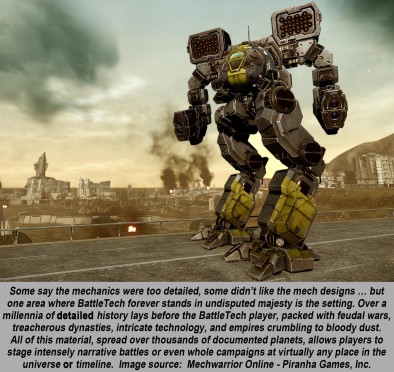
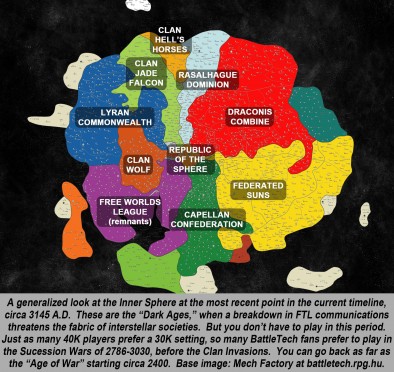
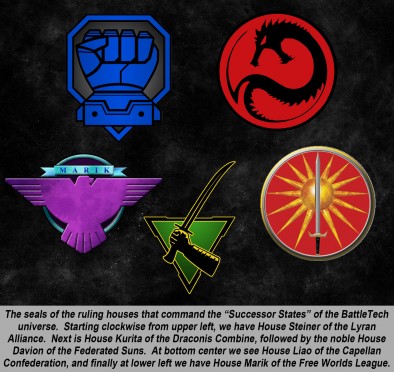
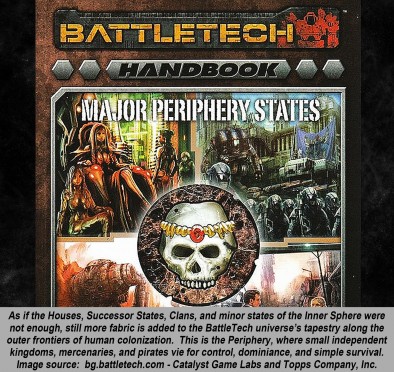
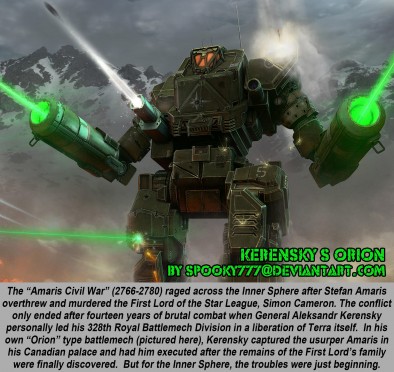

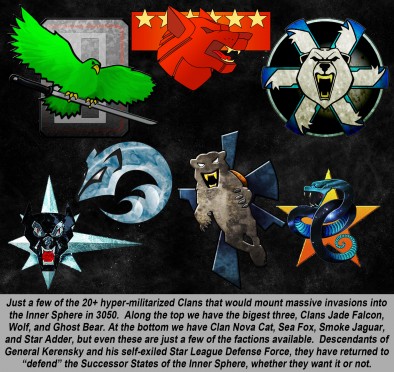

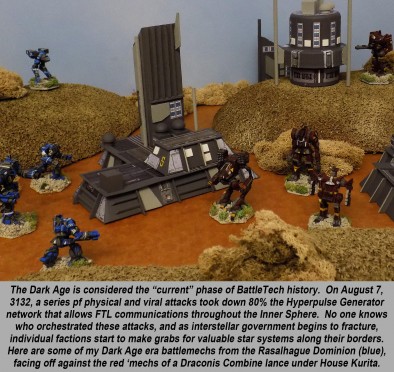
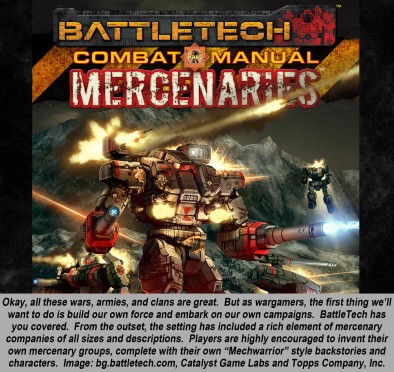


































I have to admit I did like playing the smaller Clans. I think if memory serves I used to represent the Diamond Sharks.
Lore of Battletech is fascinating and so expansive that exploring it offers lot of enjoyment. This includes lore for all different factions and they most important personalities. Everyone seems to have they own favorite era from Battletech lore with plenty of old school players seem to prefer Succession War eras that in combined lasted almost 300 years until Clans arrived to try to bring back Star League based on Nicholas Kerensky’s (Father of Clans) vision but failing thanks to most of invading clans being so naive and misguided after all generations of fighting trials instead of actual wars and believing… Read more »
Thanks, @noyjatat – Although I’m playing Clan Ghost Bears now, some players on last week’s threads were talking about some of the smaller Clans, most notably Clan Sea Fox. Some of these smaller Clans are definitely interesting, with “niche” identities and special characteristics. I may not build an “permanent miniature army” for them, but they may be fun to try out. 😀 Maybe in Alpha Strike?
Agreed buddy such a rich diverse world gives so many options. On occasions we played as a group of rogue Mercs each from a different Clan so that we could play against both Inner Sphere and the Clans and use those smaller factions units to vary our gameplay.
You know, @mecha82 – I’ve been trying to come up with a way to succinctly encapsulate the strange, borderline paradoxes in the Clan mentality and their self-prescribed “mission” which (as the lore clearly shows) they have a very tough time doing themselves sometimes. Your post actually does it rather well. 😀 The Inner Sphere’s edge in vehicles, most infantry, and other arms of combat shows that they seem to have more actual “battlefield” experience as opposed to trails (where mechs are all that matters, and Clan mechs are definitely awesome). From the Clan perspective, this might be the IS struggling… Read more »
This is where BT grinds almost all other scifi game settings into dust. Its setting and history is just so rich and amazing, it is almost mind boggling. So many amazing characters have been created over the years, and the various factions all feel so alive. If you want to start diving in to the lore of BT, I can highly recommend Michael A Stackpoles Warrior Trilogy. It is some of the best scifi writing out there. The BT setting covers such a large amount of time, that many players pick a time period to focus on, as the it… Read more »
Could not agree more on the warrior trilogy recommendation. Though the Blood of Kerensky trilogy is a close second.
My personal favorite and first one that I read is Legend of the Jade Phoenix Trilogy that tells Aidan Pryde’s story from his early years as cadet to his rise to warrior caste by playing by his own rules and his heroic death that saved Clan Jade Falcon from shame of defeat. Fact that he not only played by his own rules but also that he never gave up no matter what really shows that he was too good for his Clan. He would had been much better Wolf IMO than Jade Falcon but then again Clan Wolf was already… Read more »
@nosebiter – “grinds almost all other sci-fi settings into dust.” I love it! 😀
And thanks for the recommendations @moebiusstrip and mecha82. Blood of Kerensky and Jade Phoenix Trilogy – sounds like we have some more Clan brethren on the thread! 😀
There is effectively a fourth book in the Jade Phoenix trilogy that you might have seen or might not have been aware of – “I Am Jade Falcon”. It deals with Joanna as the central character and her struggle to achieve what a Clan warrior should want to despite her increasing age (by clan standards). It’s been a while, but it’s a very strong book and feels very much like it belongs as part of the trilogy. I have always been a big fan of Clan Wolf, so naturally have a low opinion of Falcons in general, but I loved… Read more »
Thanks for this article …and you’re right it’s near impossible to write about the history of the Battletech-Universe and not fill whole tomes in the process. Whoever didn’t know this history before and wants to learn more … well there are wikis out there with so much to read it could take a looong time to read it all 😉 And i for one liked the clans, but i also liked the time before them … so i’m happy that there are enough options and time periods in this universe to play with them, before them or during the jihad.… Read more »
And i should remember to proofread what i write before posting… I blame that PPC in my youth!
Thanks, @nosebiter – Trust me . . . as they guy who just wrote this article . . . I can completely agree that BattleTech history can be “mind boggling.” Trying to squeeze BattleTech history into just one article of less than 1800 words cost me about half a bottle of aspirin. Maybe I should have tried some of those “PPCs” @querion was mentioning. 😀 😀 Indeed the history of BattleTech is both imposing and inviting. Yes, it’s huge. Only Star Wars. Star Trek, and 40K compare in the world of sci-fi. But I also like how it’s “inviting.” The… Read more »
I want plastic Omni Mechs.
Really badly.
I know the feeling, @suetoniuspaullinus . 😀 While Iron Wind Metals has lots of Clan Mechs that I think are technically “omni mechs” in the game, it’s tough to make those “WYSIWYG” omnimech-type modular modifications to the miniatures in metal.
I’ve had some success with modifying Iron Wind Metals, cutting the mechs in half at the waist (when required), drilling holes in the torso and “pelvis”, and mounting jewelry magnets for torso-twists. But that’s pretty large-scale when compared to cutting off weapons and sensors, then plugging your new ones.
@oriskany, if you go to the IWM website and look in the scrapyard section, they sell option parts to do most of the original OmniMech variants.
Also, the Word of Blake Celestial Omnimech minis have been designed with modularity in mind – they all have two spaces in each side torso where you can mount universally-sized weapon pieces, or blanking plates if you don’t use them.
When I first started playing BattleTech, thanks to my local gaming club, games tended to be based in the Clan Invasion era, which was where the timeline was around then. Tukayyid hadn’t long happened, and the home clans weren’t really as fleshed out as the invading clans. I began to be drawn towards House Steiner as my faction, possibly thanks to the cartoon being aired on Sky TV – was it Toonami? I liked the big assaults and heavies bedecked in blue that typified the Lyran Mech forces, and I prefered the underdogs of the Inner Sphere. As we got… Read more »
@ckbrenneke – “Brenneke’s Battlers” – I love it! 😀 I may have to counter with “Oriskany’s Overpower-ers . . ” Ugh. never mind. 🙂 Interesting notes on how you organized your Jade Falcon (probably my second favorite Clan, btw) forces. I’m still learning how the Clans organize their forces myself. My Ghost Bears are currently organized as “lances” and a “company,” which is not correct. Just got my company of Total Warfare, so I hope to have that sorted soon. Great tip, @lorcannagle , re: the “Scrapyard” option for Omnimechs on Iron Wind Metals. Speaking of “blanking plates” . .… Read more »
BattleTech does indeed have a long and glorious history and so much good fiction to support it, at least up to the point of the Jihad. The Jihad, Republic of the Sphere and Dark Ages however are what I’d call lazy history to set up a future setting. As ‘Classic’ BattleTech was seemingly waning, Wizkids had a new Clix style game out and wanted to wipe the slate clean for it, so they created a terrible war, period of peace and then a dark age to suit this new game. The game didn’t last, and now BattleTech players are stuck… Read more »
@Shinygames, Wolf’s Dragoons weren’t destroyed in the Jihad, just heavily damaged. They even had minis in the MechWarrior: Dark Age game. The Dragoons are back up to three regiments and two independent overstrength batallions as of 3145, and working for House Kurita again. There’s a fantastic 4-part story on BattleCorps all about their return to Kuritan service called Redemption Rift.
Oh, and the Jihad was always going to happen after the Fedcom civil war. There’s a ton of clues and hints in FASA-era books and novels going back to the early 90s There’s a few hints dropped in the ComStar sourcebook, we learned Thomas Marik was an impostor in Assumption of Risk; In Patriots and Tyrants, Arthur Steiner-Davion was abducted by Blakists and his assasination faked, and the LAS Arthur Steiner-Davion was destroyed by a mystery ship, but the hints in the book mean it could only be a McKenna or a Potempkin, and the Blakists were the only Inner… Read more »
@shinygames – I don’t see your post as a “negative,” I can honestly see where you’re coming from. On Beasts of War I’m typically known as a map-poring historical player (where you always know how the bigger story will ultimately play out in the end . . . strange how the Germans always seem to lose World War II no matter how well they do on the table 😀 ). So when I got into BattleTech I originally wanted to play on the very leading edge, building units and games right at the “current moment” of the timeline. I wanted… Read more »
Comstar had a schism between the fundamentalist faction and the secular faction. They started getting really aggressive in the 3060 timeframe and were hoping for a seat at the big table at the Star League conference in 3067 after gaining considerable power. When the Star League disintegrated (again) in 3067, the Wobbies flipped out and started attacking darn near everyone. Wobbies were fanatical, but inexperienced. Between the clan invasion and the chaos surrounding the FedCom Civil War, nearly every unit they ran into had serious edge in combat experience to make up for their lack of numbers. This is the… Read more »
@Oriskany, Wow, @ lorcannagle – you seriously know this lore. The “advantage” of BattleTech being my primary game for about 20 years now. I’m a mod on Catalyst’s BattleTech forum, and there’s some guys on there who put me to shame. I kinda want to take a photo of my BattleTech bookcase and post it – it’s actually overflowing at this point and it’s just rulebooks – no novels! So let me ask . . . the Word of Blake is basically the “extreme” or “fundamentalist” faction of ComStar, right? I see on Ouchies Bat Reps that a lot of… Read more »
@wellspokenman – “Wobbies” – okay, took me a second to get that. 😀 And I totally get it, if you spend a long time building and investing into a universe, and then large parts of that universe get “nuked from orbit” – that’s gonna leave a sour taste in your mouth. As a newer player (outside of a HANDFUL of pre-3050 games waaay back in the “Dark Ages” of 1990-92) there’s something kind of exciting about setting up a new unit in a devastated aftermath, ready to forge (and rebuild) a new future. Again, when I’m in a “wargaming” mood,… Read more »
@ Oriskany @lorcannagle – so they began to assault Blakist positions and test the remains for DNA from Wolverine families. Now that’s epic. 😀
“All right, another victory, guys. Cool down the PPCs and reactors. And who’s turn is it to go out and scoop up the remains? No, no, no, Jorg, it was Sven’s turn last time. Come on, grab your bucket and get started.
There’s a scene not a million miles away from that in one of the later Jihad Sourcebooks.
Thanks for correcting me about the Dragoons, I hadn’t realised that. When you don’t like the broad brush strokes of a story, you often don’t stick around for the detail which might not be quite as bad as you thought.
I’d suspected that the Word of Blake was going to assert itself anyway. For me, it was the sudden and utter devastation of the Jihad rather than the idea itself that I didn’t like.
Over all I feel that Dark Age started as WK’s thing to justify lot of things about they clix based CMG like why there was all those minor factions and why industrial mechs were used in combat and why actual battle mechs were so rare. It also spoiled what was coming as Jihad had to taken place in Battletech universe at that point but was mentioned as it was before Dark Age.
@shinygames, I think a lot of people read that initial press release and previews of Dark Age and made up their mind early, and then a bunch of people got second-hand information from them, and then chinese whispers happened. To this day, there’s a guy who sometimes playes with us and insists that Wizkids planned for IndustrialMechs to be the best unit in the game, 15 years after they explicitly said they’d be a cheap way to get mechs into your army, but they’d never be able to beat a BattleMech. Now, I do think that Wizkids handled parts of… Read more »
@mecha82 and @lorcannagle – I haven’t even looked at anything concerning industrial mechs. Didn’t seem very appearing so far. These are basically weaponized forklifts and dump trucks and the like? 😀
Beware my new weapon! The XCM-01 Assault Cement Mixer! Bwahahaha!
@oriskany: @mecha82 and @lorcannagle – I haven’t even looked at anything concerning industrial mechs. Didn’t seem very appearing so far. These are basically weaponized forklifts and dump trucks and the like? 😀 Beware my new weapon! The XCM-01 Assault Cement Mixer! Bwahahaha! Yeah, they’re basically ‘Mech technicals, like the ForestryMech has a chainsaw, and a claw hand capable of lifting a redwood-sized tree once it’s cut down. But the armed version swaps out the claw for an AC/2 or similar light weapon loadout – there’s ones with rockets, or machine guns and flamers – and a jury-rigged fire control system.… Read more »
While my knowledge of the Battletech setting is sorely limited, one of the things I like about what I have seen is that it is not so much conventionally dystopic in nature as it is a story of almost-utopian outcomes that fall along the way, often at the last hurdle, and for eminently human reasons of greed, corruption, fanaticism, xenophobia and overweening personal ambition that puts the individual or elite power group over the collective good – it is all very credible as a political outcome for humanity, especially considering the way the world seems to be heading at the… Read more »
Thanks @vetruviangeek – Indeed, the setting of BattleTech is far from uniform, different regions of space are dystopian, utopian, post-apocalyptic, frontier, etc, and switching around as history swings to and fro. And as far as what causes the problems, Kerensky himself was very keen on abolishing all “nations,” religions, alliances, antipathies, fueds, etc when he founded his new Clans, determined to divorce his new society from all the prejudices, xenophobias, greeds and hatreds of the past. To a certain extent, he succeeded. But as Clan history shows, these old foibles were only replaced by new ones (TrueBorn vs. Freeborn seems… Read more »
I started reading Battletech novels around 25 years ago; unfortunately, I started with the original Clan trilogy (Way of The Clans was the first) and it gave me a very confused view of what was going on. I now own around 50 of the novels (not read them all!) and my understanding of what on earth is going on has improved dramatically, it’s even given me an appreciation and understanding of real-world history with all of its political alliances, marriages and wars. So, I’ve started back on the Warrior Trilogy, which as people have already said, is such a great… Read more »
@chillreaper – indeed it sounds as if you picked a turbulent time to jump into the history. And I know what you mean about the history, and how (despite being fictional), seems “based” on a lot of the same “historical mechanics” we see in our real-life timelines. A lot of franchises do this, e.g., Game of Thrones seems based on the War of the Roses (I should get at least 5 more responses on this thread based on that statement alone). 😀 And I also agree with what you say about different eras of BattleTech history appealing to different players.… Read more »
Yeah, my introduction to the novels was weird… Having been introduced to the game prior to reading the novels, the strapping: “life is cheap, but Battlemechs aren’t”, suddenly reading about a world where they had loads of mechs, but few pilots that they’d let use them threw me for a loop. Many years and a few dozen books later, I’d fallen in love with the universe, even though I never progressed any further than Operation: Bulldog my reading. I think that I’m going to look up a chronology and start from the beginning (whether I bother with Far Country is… Read more »
Oh man, @chillreaper , you’re stripping all your old mechs? Indeed, some of of the ones I’ve seen on eBay are . . . oh. Oh, you poor mini. I feel like I wanna buy you and take you home and show you some love. Like adopting an abused dog at the pound. “It’s okay, Mr. Arctic Wolf. Things will get better form here, I promise.” 😀 😀 Yes, and I have some old WW2 minis that are just . . . wow. I try not to put them in table photos, or if they’re really needed, I have them… Read more »
There are funny moments in BT like the planet wide brawl involving Wolf’s Dragoons and McCarrons armoured cavalry Taken in deposition after it had calmed down – Quote from: Hammer on 18 May 2014, 10:58:16 —There were two of them talking in loud voices, discussing ancient history. “Yeah,” says the first, “Philip of Macedon-you know, Alexander the Great’s father-they say that he wept over the bodies of the Theban Sacred Band after he killed them.” “The Theban Sacred Band?” says the other. “Who were they?” “The elite regiment of the Theban army. Supposedly the whole unit was made up of… Read more »
Awesome, @torros . Okay, BattleTech and the Battle of Chaeronea – two things I never thought I’d see in the same Beasts of War post. 😀
The Sacred Band were supposedly some serious badasses, though. 😀
The Theban Sacred Band were indeed the toughest military of their day (at least in the Greek region), although for a relatively brief period. Ironically, like the Dragoons they relied on their two tactical genius leaders their head to do well in battle. Unlike the Dragoons, they lost one leader in each of their great victories. I remember that text from a call-out box in the Wolf’s Dragoons Sourcebook way back. It seemed really funny at the time and well written, but is a good example of the 80s-ness of much BattleTech. In today’s world, never mind the 3020s, it… Read more »
https://www.youtube.com/watch?v=h92N63ElI4s&ab_channel=TheRageaholic
I do love Battletech lore, even all the weird odd bits of it. Like at one point some people lost so much tech people used ice packs instead of proper cooling vest/suits. Or when pilots just wore the cooling vest, helmet and shorts. There is a picture of that out there. Its fun I have to say on a grand scale and for all the little oddities that was put in there that are were just so 80’s. As for Omni models, I really think that IWM needs to step up their game and get in to that or people… Read more »
@galamere – definitely a fan and long time subscriber. Word of warning, enjoy that video with headphones, as Razorfist avails himself of the “full range and spectrum” of the English language. 😀 @spacewolflord – I have heard theories that PART of why ‘mech heat, cooling vests, etc. were written into the BT lore was so artists / fans could depict mechwarriors (especially the female ones) in attire that was hmmm . . . “less than complete.” I mean if your “work environment” ratchets the temperature up to 100, 110, 130 degrees F . . . you might start shedding parts… Read more »
I think it was just an 80’s thing. The original Nuro helmet was just a big dome that projected views of the outside on to viewing plates. I think they modified it fairly quickly to look more like a proper helmet
@torros Yes, for all they wrote in a reason for MechWarriors to dress skimpily, they then had them put these huge boxes on their heads that extended out onto their shoulders. I can only assume they wanted to capture pictures of the mechwarrior after they got out of their mech and were shaking their hair out after getting the thing off their heads.
Then there was the Advanced Neurohelmet, often worn by the Lyran Commonwealth which looked way cooler so long as you shaved a couple of patches on your head. Again, not really designed for the image conscious MechWarrior.
Yep, sweaty, half-clothed, bad-ass warrior women, strapped into a leather seat.
* sigh *
God, I miss the 80s.
😀
Another interesting and well written article. I’m not even a player of the game, but it was still accessible for me. Bad news – Dave read the last article and is going to dig out his old minis. So old that he has to go to his parents to find them!
Another excellent installment.
Thanks very much, @unclejimmy – and chalk up another victory tally on the “attics and garages score!” 😀 😀 😀
Sorry for mentioning it again but 3025 was my first love. I loved the purity of the excellent design mechanics and the richness of the background. The Kerensky Legend (with its riff on White Russia) was evocative but I felt it fell down when the Clans actually arrived. For me they were always too stylised (and isn’t that a stupid thing to say about a wargaming faction?) and they never quite ran true. Give me an unlimited pot and I would be recreating the Succession Wars on a massive series of tables and 3025 only mechs (and the great variants… Read more »
Great piece though James.
Thanks for the post, @hedleyb – And I would freely admit that many BattleTech fans are totally in agreement with you re: 3025. Including Hairbrained Schemes and perhaps “the man” himself, Jordan Weisman (creator of BattleTech) . . . since this is precisely when they’re setting the upcoming BattleTech PC game to be released next year. 😀
I know – I’m in the Kickstarter 🙂
Mind you it was only after 3050 when we got proper stats and builds for those variants and the axeman actually worked 🙂
Gotta be honest, I’ve never really been a fan of / understood the whole idea of ‘mechs in melee / brawling combat 🙂 Don’t get me wrong, to each their own. It’s just not my thing personally.
That’s what happens when you get stuck in the Clan way of thinking!
And don’t go on about filthy dishonourable freebirth tactics – that’s why mechs have arms and legs and jumpjets…
Mind you, I did get my Wasp punched to pieces by a Wolverine in my game yesterday – I’d obviously forgotten about melee attacks, too!
Although, as a Ghost Bear, none of my ‘mechs have jump jets, and I’m not a fan of physical attacks (we have laser-guided, computer-controlled energy-based and guided smartweapons that can hit at 3000+ meters . . . so naturally the best choice is to trundle up to the bastard and punch his giant robot in the face) . . . I DO confess to looking forward to seeing my first properly executed “Death from Above.” 😀
Great summary, especially given the space constraints of the article. When I try to summarize Battletech it takes an hour.
Indeed, @vensersrevenge – it isn’t easy. Best to “bookend” the presentation with disclaimers – “This is only the broadest of summaries . . . ” 😀
@oriskany Thanks for the article. I remember playing the Jade Falcon when it comes to clans and Wolf’s Dragoons for the mercs. Ah, good ol’ Jamie Wolf.
On a side note I have just downloaded all the free pfds available for the game 🙂
BattleTech will always be my first wargaming love, the game that started my plastic crack addiction. And I will always be a Free Worlds League Locust since my first learning game with my father.
Thanks, @yavasa – Yeah, seems to be a lot of love for Wolf’s Dragoons on this thread. 😀 Awesome to year about the .pdfs. 😀 There’s a lot of it out there, especially the older 80s and 90s materials.
And thanks as well, @mistahsly . Man, you played BattleTech with your Dad? That’s awesome. I just finished a couple of Iron Wind Metals Locusts (IICs) myself Saturday, worked late to get them ready for a game on Sunday. 😀
Yep @oriskany and you can download for free some stuff from the current owner at their official store 🙂
It’s weird but as a European (British) I always saw Davion as American and the FWL as Austria for some reason. A different read than the oracle that is James. Steiner felt Scottish/British to me (+ Scandanavian of course) – mind you I was always Kurita or Mercs when I played.
The ethnicities of the Successor States become far more complex when you get into it, especially as they tend to mix cultural heritage and ethnicity up a bit. So while House Davion talks about freedom and liberty in the best American tradition, their culture is closer to Britain (and more specifically England) and France. Similarly the Free Worlds League resembles the US politically in as much as the member states are semi-independent, and the central government has limited power, but ethnically they’re a mix of eastern Europe, Greece, Spain, and a ton of others. The Draconis Combine is culturally Japanese,… Read more »
A great read @oriskany
The jade falcon & bear clan’s seem to bring back memory’s of the games I played in the 90s.
@hedleyb – of course I have no special insight into the minds of the original BattleTech creators, but the eagle as their standard, their “melting pot” inclusion of many different cultures, their history of rebellion against colonial meddling from the “mother country,” and the fact that when you’re a supporter of House Marik, you’re “a Merik-an?” (yes, the old FASA designers had that corny of a sense of humor sometimes in both BattleTech and Shadowrun). Of course that whole purple scheme throws it off, so who knows? Thanks, @zorg – yep, these memories last a lifetime. 😀 Honor to Clan… Read more »
@oriskany to be honest I have always seen FWL as Balkan considering how much it has been in civil wars and how much thee has been revolts in FWL and difficult it has been for House Marik to keep things under control. This is includes how difficult it has been for FWL to organize offensive and why they have always been defenders rather than offenders.
@Oriskany, like I said upthread, the Free Worlds League is American politics with Balkan, Greek and assorted other ethnicities.
There is an pretty awesome video out there that sums Battletech up pretty good.
https://www.youtube.com/watch?v=h92N63ElI4s
Enjoy ! 🙂
Ah, Razorfist. 😀 Indeed, @nightmarus – I’m a longtime fan and subscriber. We were talking about that above, I think, with @galamere .
Crusader Colonel Roary Graves of the mercenary *Free Lancers*, perennially employed by House Marik, reporting for duty! My group started playing about a month after the first box set, standees & thin paper maps & all, came out. It still even had a couple typos about it being Battledroids! & the Succession Wars, tho mentioned, took a backseat to battling over clean water resources. Need that high grade h20 to keep the fusion engines goin! [Oh & to live on, too…] Have played just about every iteration, sans card games, through the years. From the original box set to the… Read more »
As someone who came to Battletech via the Mechwarrior videogames, a copy of the first Dark Age novel that was sitting on the shelf in my local Borders and a huge lot of Age of Destruction stuff I won at a con (still not sure how that worked out…) I’ve a bit of a soft spot for the early 3100 setting. Seeing how the various factions had rebuilt post-Jihad was fascinating, and as I read more of the back-lore there was a neat moment when the origin of the Republic of the Sphere’s most secretive unit got revealed in one… Read more »
Awesome post, @blasterca , or should I say Colonel Graves. 😀 Yep, I still have tons of those paper maps folded up in my closet, we used them for many games other than BattleTech, took (some of them are really tattered after years of love, fire, blood, and tears). 😀 Never played BT with the cardboard standies, though. There is a “fan movie” for BattleTech out there. Not bad, considering, about the same level as the old Mark Hamil Wing Commander “movie” *ahem*. 😀 @dawfydd – See, despite my heavy wargaming impulses and draw to the clans, I still want… Read more »
The nice think about The Dark Age is that across the various books they eventually touch base with all the factions, and the Rasalhague Dominion gets some of the nest of that. I did quite like how initially they dealt with the small factions that cropped up within the Republic of the Sphere once the HPG network went down, all inspired by one of the larger factions that was their cultural origin, making grabs for power to secure pieces of the Republic either for themselves or their backing power, and then later these powers took a more direct hand in… Read more »
Another great article @oriskany. I have always loved that the Great houses traced their heritage back to a tradition here on Terra. The Japanese culture of the Draconis Combine, the German and British tradions of the Lyran Commonwealth (Lyran Alliance, whatever), The Greek Traditions of the Free Worlds League, the Chinese history of the Cappelan Confederation, and the American traditions of the Federated Suns, give all of these factions roots dating back to our times and before, bringing people in from the begining. The history of the inner sphere is our history. One of the aspects of the Lore that… Read more »
Great post, @rgreenparadox – I hadn’t read anything about the covert ops units or secret police. Makes sense, though, considering the amount of spycraft, intrigue, and assassinations that go on in these stories. So the House Marik / Free Worlds League is based on Greece? i.e., the Athenian League? So far we’ve had the US, the UK, and even the Balkans put forward as other candidates. 😀 I’m getting the feeling the creators were playing a lot of mix-and-match. On the Davion / Federated Suns side, we have units designated as “Fusiliers, guards, and lancers,” all sound very British (although… Read more »
Another clue to the origins of each house are the ingredients in the PPC from their nation. The drink is basically grain alcohol cut with one shot of something else. PPC 4 shots everclear 1 shot of: peppermint schnapps (steiner) sake (kurita) ouzo (marik) plum wine (liao) bourbon (davion) tequila (capellan march)(davion, think US SW) That thing is just wrong.